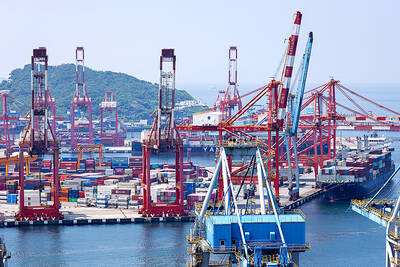The New Taiwan dollar rose to its highest in four and a half years on speculation that overseas buyers will increase demand for the currency as they raise their investments in Taiwanese stocks.
The NT dollar gained NT$0.133, or 0.4 percent, to close at NT$31.199 against its US counterpart on the Taipei foreign exchange market.
That figure was the highest close since Sept. 15, 2000.
As of yesterday, fund managers abroad bought a net NT$92 billion (US$2.9 billion) of Taiwan's shares this month, compared with net sales last month, according to stock exchange figures.
The continued appreciation in local currency has caused domestic textile makers to publicly petition the central bank to intervene in the foreign exchange market.
In a statement released on Tuesday night, textile makers complained that a stronger NT dollar is eroding their competitiveness and earnings as they compete against their Chinese rivals in the US and Europe.
The NT dollar also strengthened yesterday after the central bank said in a statement that it hasn't been selling the US currency.
"The [central] bank has not been selling US dollars. Foreign media reports are inconsistent with facts," the bank said.
The remark came as a Chinese-language business daily reported yesterday that "according to foreign media reports, the US dollar declined sharply as Taiwan's central bank and the Bank of Korea plan to sell the US currency."
Earlier in the day, the Bank of Korea said the market had misunderstood reports on the issue. It insisted that it had no plan to sell some of its dollar forex reserves.
At the same time, the bank said it did plan to diversify its forex reserves in the interest of securing a better investment return.
"That they haven't been selling the dollar doesn't mean they won't sell," Tommy Ong, vice president of the treasury and markets at DBS Bank (Hong Kong) Ltd, a unit of Southeast Asia's biggest lender by assets.
"They want to avoid a freefall of the US dollar because obviously they have a pretty large portion of the dollar in their reserves," he said.
The NT dollar may rise to NT$30.25 against the greenback in about a month, Ong said.
Lehman Brothers said yesterday in a report, Taiwan's Temporary Pause, that "Faced with renewed upward pressure on the NT dollar, we judge that Taiwan's central bank would once again [at least initially] intervene heavily in the forex market."
The NT dollar pared gains of as much as 0.6 percent on speculation the central bank sold its some of its currency holdings, said Joseph Lee, a currency trader at Cathay United Bank (
``There was speculation that the authority sold the Taiwan dollar just to slow down its gains,'' he said.
George Chou (
The NT dollar's gains may also encourage some exporters to convert overseas earnings on concern the currency's advance may accelerate, said Gary Huang, a currency trader at Union Bank of Taiwan (
A strengthening currency reduces the amount of foreign-exchange proceeds such companies can get out of their profits.

Nvidia Corp chief executive officer Jensen Huang (黃仁勳) on Monday introduced the company’s latest supercomputer platform, featuring six new chips made by Taiwan Semiconductor Manufacturing Co (TSMC, 台積電), saying that it is now “in full production.” “If Vera Rubin is going to be in time for this year, it must be in production by now, and so, today I can tell you that Vera Rubin is in full production,” Huang said during his keynote speech at CES in Las Vegas. The rollout of six concurrent chips for Vera Rubin — the company’s next-generation artificial intelligence (AI) computing platform — marks a strategic

REVENUE PERFORMANCE: Cloud and network products, and electronic components saw strong increases, while smart consumer electronics and computing products fell Hon Hai Precision Industry Co (鴻海精密) yesterday posted 26.51 percent quarterly growth in revenue for last quarter to NT$2.6 trillion (US$82.44 billion), the strongest on record for the period and above expectations, but the company forecast a slight revenue dip this quarter due to seasonal factors. On an annual basis, revenue last quarter grew 22.07 percent, the company said. Analysts on average estimated about NT$2.4 trillion increase. Hon Hai, which assembles servers for Nvidia Corp and iPhones for Apple Inc, is expanding its capacity in the US, adding artificial intelligence (AI) server production in Wisconsin and Texas, where it operates established campuses. This

Garment maker Makalot Industrial Co (聚陽) yesterday reported lower-than-expected fourth-quarter revenue of NT$7.93 billion (US$251.44 million), down 9.48 percent from NT$8.76 billion a year earlier. On a quarterly basis, revenue fell 10.83 percent from NT$8.89 billion, company data showed. The figure was also lower than market expectations of NT$8.05 billion, according to data compiled by Yuanta Securities Investment and Consulting Co (元大投顧), which had projected NT$8.22 billion. Makalot’s revenue this quarter would likely increase by a mid-teens percentage as the industry is entering its high season, Yuanta said. Overall, Makalot’s revenue last year totaled NT$34.43 billion, down 3.08 percent from its record NT$35.52

PRECEDENTED TIMES: In news that surely does not shock, AI and tech exports drove a banner for exports last year as Taiwan’s economic growth experienced a flood tide Taiwan’s exports delivered a blockbuster finish to last year with last month’s shipments rising at the second-highest pace on record as demand for artificial intelligence (AI) hardware and advanced computing remained strong, the Ministry of Finance said yesterday. Exports surged 43.4 percent from a year earlier to US$62.48 billion last month, extending growth to 26 consecutive months. Imports climbed 14.9 percent to US$43.04 billion, the second-highest monthly level historically, resulting in a trade surplus of US$19.43 billion — more than double that of the year before. Department of Statistics Director-General Beatrice Tsai (蔡美娜) described the performance as “surprisingly outstanding,” forecasting export growth